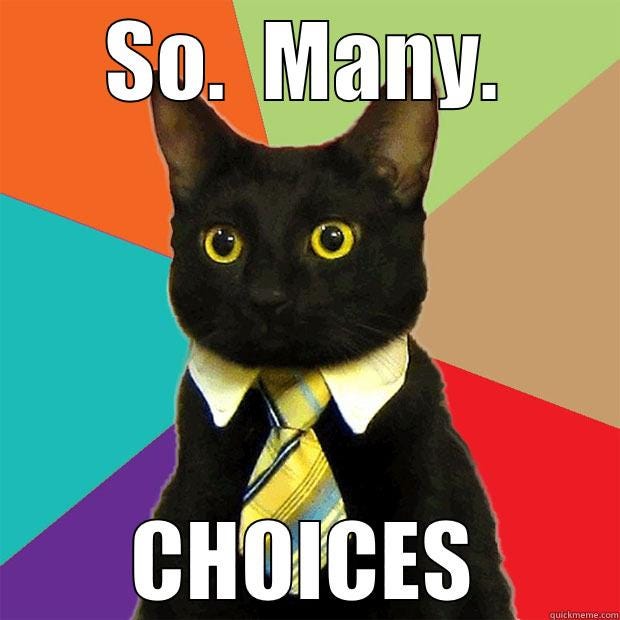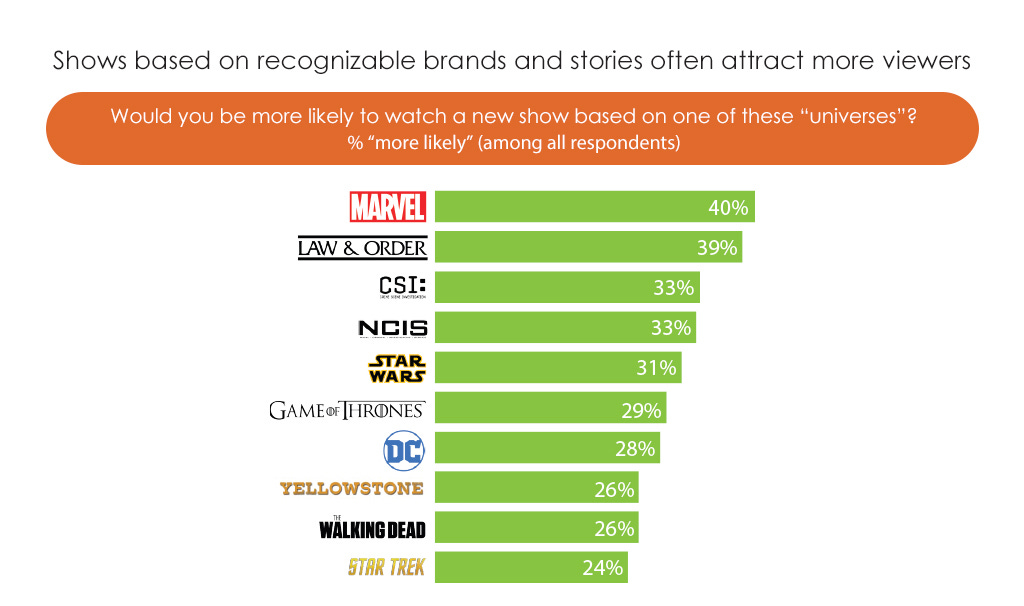The Paradox of Choice and the Content Discovery Dilemma
Tell me, how does this question make you feel? ➡️ What’s for dinner?! 🍽️ Did you cringe?
Welcome to Hub Intel. We’re here to provide data, not drama. Our goal is to help you understand the trends in the entertainment industry and what they mean to your business.
The Paradox of Choice and the Content Discovery Dilemma
These days, deciding what to watch can feel as painful as trying to figure out what to eat for dinner. As the media landscape has become more fragmented, these decisions have only become more daunting. In fact, audiences now spend an average of 10.5 minutes searching for something to watch.1
When faced with option overload, 20% of people simply shut down and do something else instead like doom scroll on TikTok or Instagram.2 It should be ideal to have everything at your fingertips, but the reality is a lot more complex.
The Paradox of Choice
Content providers need to understand that their viewers have decision fatigue. The Paradox of Choice – Why Less is More was published by psychologist Barry Schwartz in 2004. He argued that eliminating choice can reduce anxiety for consumers.
That said, it’s hard to have self-awareness about this phenomenon. Ironically, 43% of viewers are positive about the abundance of choice in TV shows - up almost 50% from 2020.3 Additionally, among those who sign up and cancel quickly, the most common reason is that “I ran out of things to watch.”
Given that every platform has thousands of titles – more than any normal human has time to consume – I believe, it’s more likely that they just can’t find something they want to watch in the endless sea of options.
As a former Warner Bros. Discovery Programming Executive turned Independent Media Consultant, I use this philosophy to help my clients understand that the easier they can make the decision tree for their audiences, the better, and Hub Entertainment Research is my go-to source for data to support my strategic thinking.
So, let’s take a look at the two big choices audiences have to make when it comes to what to watch.
Choice #1: What Am I In the Mood For?
Remember your audience is multidimensional, and their mood state changes on a daily basis. Are they looking to escape? To laugh? To cry? Do they want something new? Or nostalgic?
It’s also important to keep in mind that TV isn’t just competing with TV. In fact, TV viewing makes up 43% of screen time for audiences 35+ with the rest dedicated to movies (17%), social media (9%), online videos (11%), gaming (10%), e-books (6%) and other options (4%).4
We all know there are more viewing platforms than ever, but the reality is, due to the Paradox of Choice, most have their default favorite channels or platforms.
Whether they realize it or not, audiences have these default favorites because the services are meeting their emotional needs at the time of viewing, so that is where they will begin their content discovery journey. The default phenomenon is also illustrated by the study below. Users have preferences for their must-have platforms.
This is why building brand loyalty is so important. Whether it’s through a steady drumbeat of premium originals, familiar IP, or appealing to a niche fandom, platforms need to have a clear brand promise to become a favorite.
Want to know a shortcut to becoming a default? Bundling, of course! What is old is new again! It’s what cable always got so right. Now the industry at large is figuring out what bundling outside of linear looks like.
There are so many ways to do it and experiments in progress – whether it is bundling tech and content (i.e. Amazon) or exploring bringing competitors together under new joint venture agreements like the yet-to-be-named Sports Service recently announced between ESPN, Fox, and WBD. In general, consumers are very open to bundling as you can see in the chart below.
Choice #2: What Am I Going to Watch?
Once you have a viewer in your ecosystem, what can be done to ease content discovery?
Think about yourself. Have you ever been caught in an algorithm filter bubble? Are you tired of an app pushing its number one priority in a genre that you don’t care about? The answer is probably yes because only 10% of viewers say algorithmic platform recommendations consistently send them shows they like.5
There are so many inputs that consumers must digest as they decide what to watch — from word of mouth to algorithms to trailers and everything in between. The chart below rounds up the primary factors that motivate audiences to make that final click.
However, this is the entertainment business, and we can’t forget that content is ultimately king. Hit shows (new or old) will motivate audiences to show up regardless of the platform.
What’s Next? The Industry Must Address the Paradox of Choice for Audiences.
➡ Fewer, Bigger, Better? The reality is business and monetization models of the streaming era have meant providers are downshifting production and prioritizing doing MORE with LESS. (i.e. embracing The Paradox of Choice). “Peak” tv is over. John Landgraf’s FX research team has been tracking original scripted series across US platforms for 2+ decades, and they revealed that 2023’s tally at 516 was down 16% versus 2022. Some of this decline may be due to the strikes in 2023, but with current headwinds, I don’t believe we will see a return to the peak any time soon.
➡ Windowing Matters. The good news for viewers is that the lifecycle of a piece of content will expand as it travels across various platforms from linear, to VOD, to FAST, etc., so audiences have multiple chances to find it along the way. With less new content in circulation, there will inevitably need to be more windows of opportunity to view and monetize every piece of content. Competitors are back to opening their libraries up to one another (for a price!), so audiences can see HBO shows on Netflix or AMC shows on Max!
Say it with me. Content cannibalization is officially canceled!
Elongating the viewing experience during the first-run window over time is also back in a big way. Not everything is meant to be binged immediately. This allows longer promotional periods and for word-of-mouth buzz to build.
Content teams need people power to plan their release strategies and ensure there is a steady drumbeat of promotional content throughout the year. Marketing a huge tentpole without a plan to quickly follow it with like-minded content (be it new or library) to keep your audiences coming back for more is a missed opportunity.
➡ Technology Enhancements Are Critical. While I will forever advocate for human resources, powerful machines are 100% the way of the future when it comes to content discovery. This is in part why Big Tech has given Big Media a run for its money. And if it’s working correctly, audiences might not even realize they are using it to make their viewing decisions. For example, connected TVs are influencing content discovery before audiences even go to their default favorites, and people fall into watching something on FAST without even knowing they are doing it.
Technology will continue to improve product performance driving personalization with universal search, custom trailers, smart metadata, better onboarding, and even features like interactive reviews.
And yes, there’s AI too. I love a good recommendation bot, and we are going to see them pop up more and more. For example, Cineverse just announced their AI offering, cineSearch, with an advisor named Ava.
The Big Takeaway: Simplicity!
While this all may seem rather basic and intuitive, I’m reminding you of it today because when you’re stuck in the grind of day-to-day meetings, it’s easy to fall into strategies that are more complicated than they need to be. Just quiet all that noise, and think like your audience. Don’t let your fear of the unknown get in the way.
Of course, creating a hit is no simple feat with audiences being pulled in so many directions, but services that make it EASY for their viewers will pull ahead of the rest. With thoughtful curation done by both human and machine, smart windowing, and continuous product enhancements, publishers will be set up for success.
Thanks for reading! My door is open to all who’d like to connect on LinkedIn and talk shop. The entertainment industry may be in disruption, but even so, I love solving these problems to ultimately serve audiences great content.
Best,
Sara
ICYMI: Hub In the News:
For Gen Z, Everything is Entertainment
“There’s no doubt that younger viewers are not as devoted to traditional TV and movies as previous generations have been. This presents one more challenge to legacy media companies as they navigate the future of the video ecosystem. It would be futile for them to try to claw back time from non-traditional platforms, so instead media companies should look to social media as opportunities to reach GenZ with premium content.” — Mark Loughney, Senior Consultant for Hub
Leveraging Hub’s research, here are 5 takes on what the data is telling us about GenZ:
The Streamable: Almost 90% of GenZ Viewers Watch Video on Phones Weekly: Are Mobile Streaming Plans Coming to the US?
Advanced Television: For GenZ, Everything is Entertainment
TvTech: Changing GenZ Media Consumption Habits Are Trend Setters for Other Age Groups
Media Play News: GenZ Prefers Non-Premium Video, Video Games, Social Media on Their Cell Phones
CNET: Many of My Friends Don't Own TVs, But That Could Change Soon
Want More Hub Intel?
Hub Intel is a reader-supported publication. Become a paid subscriber to get access to exclusive Hub white papers and deep dives on key topics as well as admission to Hub’s quarterly webinars.
About Hub Entertainment Research
Hub Entertainment Research, which celebrated its 10th anniversary in 2023, tracks how technology is changing the way people find, choose, and consume entertainment content: from TV and movies to gaming, music, podcasts, and social video. Hub’s studies have covered the most important trends in providers, devices, and technologies since 2013. We work with the largest TV networks, pay TV operators, streaming providers, technology companies, and studios to assess the present and forecast the future.
Learn More: Visit our website
Follow Us: LinkedIn
Get In Touch: Email us at hubintel@substack.com
Source: Nielsen U.S. streaming content consumer surveys 2023
Source: Nielsen U.S. streaming content consumer surveys 2023
Source: Hub 2023 Conquering Content
Source: 2023 Hub Highlight Reel
Source: Hub Conquering Content 2023












